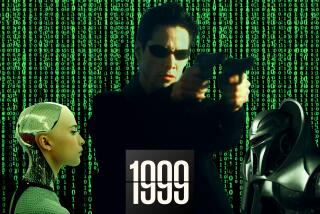Review: Unnerving consideration of artificial intelligence in ‘Ex Machina’

<p>Kenneth Turan reviews ‘Ex Machina’ starring Domhnall Gleeson, Alicia Vikander, and Oscar Isaac. Video by Jason H. Neubert.</p>
Shrewdly imagined and persuasively made, “Ex Machina” is a spooky piece of speculative fiction that’s completely plausible, capable of both thinking big thoughts and providing pulp thrills. But even saying that doesn’t do this quietly unnerving film full justice.
The compelling directorial debut for novelist and screenwriter Alex Garland, “Ex Machina” is also an involving chamber drama featuring emotional moves and countermoves by a trio of individuals played by Domhnall Gleeson, Oscar Isaac and Alicia Vikander. Except one of them just happens to be machine-made.
The title “Ex Machina” comes from the Latin phrase deus ex machina, translated as god from the machine. Its origins have to do with Greek drama, but the reference here is to man playing god, to the unthought-of complications involved in creating sentient life.
------------
FOR THE RECORD:
“Ex Machina”: A review in the April 10 Calendar section of the sci-fi movie “Ex Machina” included a reference to a “Touring test.” The correct spelling is Turing, after Alan Turing, the British mathematician who conceived the test. —
------------
Stories about artificial intelligence are a frequent science fiction topic, from Czech writer Karel Capek’s 1920 play “R.U.R.” (which coined the term “robot”) to Spike Jonze’s invisible “Her.” But the lumbering image that the word “robot” conveys is all wrong for Ava, stunningly played by Vikander, a creature of otherworldly delicacy and beauty who intentionally doesn’t look like AI we’ve seen before. Simultaneously naive and knowing, she seems to be discovering the world right before our eyes.
Before we get to Ava, however, we meet Caleb Smith, expertly played by Gleeson, who here combines a smidgen of savvy with his trademark open-faced innocence.
Caleb works for Blue Book, the world’s most successful Internet search engine, and the film opens with his winning first prize in a company-wide lottery. He’s to spend a week with Blue Book’s brilliant and fabulously wealthy but reclusive CEO, Nathan Bateman (Isaac), who lives such a removed life in the wilds of Alaska that you can helicopter for two hours over his property and still not reach his house.
As played by the chameleon-like Isaac (“Inside Llewyn Davis,” “A Most Violent Year”), Nathan is a formidable individual, intimidating mentally, physically and psychologically. With his buzz cut, full beard and imposing physique, the man is arrogant and self-involved. He clearly thinks he knows it all, but does he, and even if he does, how completely can he be trusted?
Nathan’s compound (filmed in Norway) is not just a house; it’s a research facility filled with “enough fiber optic cable to go to the moon and lasso it.” Living alone except for Kyoko (Sonoya Mizuno), an enigmatic Japanese servant who speaks no English, Nathan has been working on creating artificial intelligence and now wants to put his creation to the test.
So Caleb is there, as it turns out, to do a kind of Touring test (conceived of by the British mathematician of “The Imitation Game”) on Nathan’s creation to determine whether Ava is capable of experiencing real emotions or just simulating them.
One reason for the success of “Ex Machina” is that Ava herself, in terms of design, acting and technology, is such a remarkable and compelling creation. Conceived by the comic book artist known as Jock, her look combines shiny mesh with translucent material on her arms and torso that reveal the mechanism within. “You can see that I am a machine” is one of the first things Ava says to Caleb, and, after six months of post-production work by Andrew Whitehurst of VFX house Double Negative, the film’s visual effects supervisor, that edgy combination of human and machine is exactly what we see.
None of the effects would function as persuasively as they do without the initial work of Swedish actress Vikander, best known for that country’s Oscar-nominated “A Royal Affair.” In addition to being a fine actress, Vikander is trained as a ballerina, so she’s capable of unsettlingly precise movements that convincingly position her as a combination of human and machine.
“Ex Machina” is structured around a series of daily conversation sessions that Caleb has with Ava in a glass-walled observation room, increasingly intimate chats that Nathan eavesdrops on via closed circuit cameras.
As these two chat, banter, even flirt, their emotional connection strengthens, which raises any number of tantalizing questions. What are the implications, the responsibilities, the consequences of getting emotionally involved with a machine?
Garland has written science fiction screenplays before (“Sunshine,” “28 Days Later,” the adaptation of Kazuo Ishiguro’s “Never Let Me Go”), and he is completely at home in the genre. It was, for instance, his idea that Ava’s intelligence comes from Nathan’s ability to hack into all of the world’s digital devices.
Even more impressive, given that this is his directing debut, is Garland’s ability to keep the film quiet yet intensely involving. A scene of Ava putting on clothes is as erotically charged as someone taking them off in a more conventional feature.
Garland has also hired all the right people, including cinematographer Rob Hardy, editor Mark Day and production designer Mark Digby. The film’s aural element, combining sound design by “Gravity” Oscar winner Glenn Freemantle with a score by Geoff Barrow of Portishead and Ben Salisbury, is calculated to keep us off balance and unsettled from beginning to end. In a film like “Ex Machina,” that’s just the way it should be.
More to Read
Only good movies
Get the Indie Focus newsletter, Mark Olsen's weekly guide to the world of cinema.
You may occasionally receive promotional content from the Los Angeles Times.







